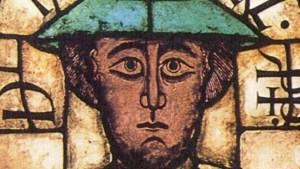Giovanni di Fidanza, better known as St. Bonaventure, was a Franciscan bishop and cardinal, a contemporary of St. Thomas Aquinas, and one of the greatest theologians in the Church’s history. Like his Dominican counterpart, he is remembered as a prime example of the scholastic (that is, philosophical) approach to theology in the medieval period. As with his counterpart, this work tends to overshadow his Scripture commentaries, which present a very different aspect of St. Bonaventure’s mind.
Though traces of the logical, systematic approach are still present in St. Bonaventure’s commentaries on the various books of Scripture, another mode of exegesis is also operating: something more like the Church Fathers, a deep spiritual reading that employs metaphor, symbolism, and arguments from fittingness.
The Church Fathers developed this way of reading Scripture as a way of solving a conundrum faced by the early Church: how do we read the Old Testament and New Testament together? If Christ is indeed the Word of God, how do we find him in books written hundreds of years before his birth? Some, like Marcion, claimed we couldn’t—that the God of the Old Testament was a wholly different being from the Father of Jesus. Others, from St. Paul onward, saw figures, prophecies, and foreshadowings of Christ throughout.
We see just such a spirit at work in the Old Testament commentaries of the great medievals. One clear example can be found in St. Bonaventure’s commentary on the Book of Wisdom.
Wisdom was written around 50 years before the birth of Christ, most likely originally in Greek. Because of its recent and non-Hebrew origins, some groups of Jews didn’t count it as Scripture. To Christians, however, the book seemed not only an excellent work in the line of Proverbs or Sirach, but one section in particular could be read as a prophecy of the passion of Christ.
St. Bonaventure’s commentary helps us to make the connections.

Read more:
How was stained glass made in the Middle Ages?
The second chapter of Wisdom (Wisdom 2:12-24) describes a plot against “the just one” who opposes the actions of the wicked and passes judgment on them. St. Bonaventure writes that “the just one” is understood to be Christ, citing examples from the New Testament showing that Christ was truly just or sinless (e.g. 1 Peter 2:22—“He committed no sin”), as well as other prophecies from the Old Testament that referred to the Messiah this way (e.g. Jeremiah 23:5—“I will raise up from David a just branch”). Thus, bringing together proofs from both testaments, St. Bonaventure shows that Wisdom here speaks of Christ.
The Book of Wisdom also says the wicked hate the just man because “he professes to have knowledge of God and styles himself the son of God.” A Christian reader would easily identify this description with Jesus. But, going a step further, St. Bonaventure also points out how this prophecy from Wisdom not only describes Jesus’ words, but the words of Jesus’ accusers about him, as in John 5:18, which says, “He also said God was his Father, making himself equal to God.”
Next the accusers in Wisdom say, “With violence and torture let us put him to the test, that we may have proof of his gentleness and try his patience. Let us condemn him to a shameful death.” St. Bonaventure tells how the circumstances of Jesus’ passion and death match this: the scourging, the verbal abuse, his death by crucifixion, in the place where the heads of the decapitated were disposed of (thus Golgotha, “the place of the skull”). But not only does St. Bonaventure show how Wisdom prefigures the passion of Christ; he also shows how other Old Testament prophecies prefigure Wisdom! For example, he connects Wisdom 2:15 (“his ways are different”) with Isaiah 55:8 (“My ways are not your ways”), and Wisdom 2:16 (“We are esteemed by him as triflers”) with Zephaniah 3:18 (“The triflers that departed from the law, I will gather together”).

Read more:
Kill them all and pluck out your eyes: Understanding Scripture’s hyperbole
This habit of St. Bonaventure and the Church Fathers demonstrates a truth of the Catholic faith: that Scripture is not a mere collection of books, but an integral whole in itself. Not only does “the new reveal the old, and the old conceal the new,” but in the light of Christ, we are able to connect different parts of the Old Testament together we couldn’t before.
This is the Catholic approach to Scripture: to see Christ on every page, and every page connected to each other in Christ. The writings of St. Bonaventure show us the way to do this.

Read more:
Just 2 min a day with the Gospels, and your life will change, says Francis

Read more:
Did Bibles always look like Bibles?

